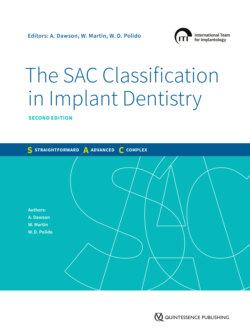Читать книгу The SAC Classification in Implant Dentistry - Группа авторов - Страница 30
2.4 Classification Rationale
ОглавлениеIn the 2009 version of the SAC classification (Dawson & Chen, 2009) the main determinants of the classification were:
• The esthetic risk
• The complexity of the process
• The risks of complications
These factors were considered for each of the treatments considered in this publication, and a normative SAC classification was derived for each of these case types. Further modifiers were considered that might increase or decrease the level of complexity or risk, but these did not change the normative classification for the case type.
In this update, the normative classifications have been reviewed, but they have not altered greatly. These are still based on the factors above, with an increased emphasis on the SAC classification as a risk management instrument.
The updated SAC Assessment Tool now allows users to derive a SAC classification for their specific case based on the pattern of risk factors that they report. Risks are considered in four broad areas:
• General risks These are the issues normally identified during anamnesis and the initial clinical assessment and are mostly patient related.
• Esthetic risk Esthetic issues are often the patient’s only way of measuring the treatment outcome. This is more than a consideration of “is the treatment site visible during function and/or smiling, and are the peri-implant mucosal tissues visible?” but also includes other factors described by Martin and coworkers (Martin et al, 2017) in their discussion of the esthetic risk assessment for single-tooth implant prostheses. Esthetic risk assessment for more extensive tooth replacement situations have also been considered.
• Edentulous esthetic risk When patients undergo complete loss of teeth, several unique clinical factors specific to this patient subset can have a significant influence on esthetic outcomes. The edentulous esthetic risk assessment will highlight these factors as they influence particular case types.
• Surgical risk Factors influencing the complexity and risk of the surgical phase of treatment.
• Prosthetic risks Factors relating the implant-supported prosthesis; for example, the clinical processes involved, the mode of manufacture, the materials used, and the design employed.
Each of these areas will be considered in more detail later in this book.
